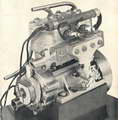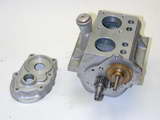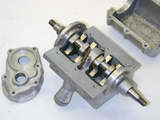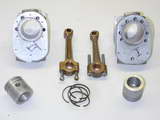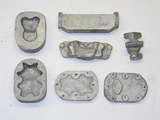The "Seagull" 10cc Twin Four-stroke
Created: May 2007
In 1950, Edgar T Westbury published a design for a 10cc, twin cylinder, four-stroke, side-valve petrol engine that he dubbed the Seagull. As explained in the introductory article from the Model Engineer, Volume 103, Issue #2564 of July 19, 1950, the engine evolved from his earlier 15cc four cylinder, side-valve Seal, sharing many of the concepts, although none of the parts. Construction was serialized over the remainder of the year, culminating in Issue #2587 with an adaptation of the basic design to a single cylinder, air cooled variant of the engine. Although not named in the text of that issue, this engine became known as the Seamew. Plans for the Seagull are still available through the Model Engineer Plan Service, code PE25, where it is described as ...the classic "launch" engine.
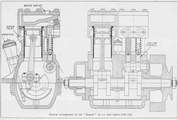 As seen in the General Arrangement, the crankshaft is machined so that the pistons move in unison. ETW chose this configuration so that the "rocking couple" caused by having the pistons move anti-phase is eliminated. So instead of shaking and rocking, it just shakes. The advantage is one cylinder can be on the compression stroke while the other is on the exhaust stroke. This evens out the firing pulses to one every 360 degees and allows a lighter flywheel to be used. It also allows him to dispense with a distributor—just fire both plugs at the same time every cycle; the spark in the cylinder that is exhausting will do no harm and the engine is significantly simplified. However this does turn the crankcase into a pump, just like a two-stroke, so the crankcase breather is arranged with a simple flutter valve.
As seen in the General Arrangement, the crankshaft is machined so that the pistons move in unison. ETW chose this configuration so that the "rocking couple" caused by having the pistons move anti-phase is eliminated. So instead of shaking and rocking, it just shakes. The advantage is one cylinder can be on the compression stroke while the other is on the exhaust stroke. This evens out the firing pulses to one every 360 degees and allows a lighter flywheel to be used. It also allows him to dispense with a distributor—just fire both plugs at the same time every cycle; the spark in the cylinder that is exhausting will do no harm and the engine is significantly simplified. However this does turn the crankcase into a pump, just like a two-stroke, so the crankcase breather is arranged with a simple flutter valve.
Back in 1950, casting sets for the Seagull were provided by Craftsmanship Models Ltd of Ipswich (UK). This company was the official supplier for most of ETW's designs and also supplied castings for the 15cc Seal, 30cc Seal major, 2.5cc Ladybird, 30cc Atom V, 15cc Phoenix, 10cc Ensign, 5cc Cadet, and 10cc Craftsman Twin (one of only two ETW designs never to be published in the ME). From the relative scarcity of photographs appearing in the ME, it would appear that the Seagull is not one of the more popular ETW designs, and I've never seen a Seamew. Like many model engineering projects, it's likely that many casting sets went under the bench for a rainy day, then to the tip when the owner's demise preceeded that rainy day. Others would have progressed to some state before apathy or some problem called a halt to construction.
The latter is most likely the case with the Seagull parts pictured below. The unknown builder has done quite a good job of the crankshaft and an adequate job of the camshaft. The cylinder liners are well finished, nicely honed, and the rings, if a bit wide by modern standards, are a good fit. Although I can't say with any certainty, my guess is that two mistakes caused the builder to pause for thought, and never resume construction.
All the problems center around the cylinder castings. First, the liners are press fits and were almost certainly honed after pressing in (to do otherwise is stupid and the builder appears to have been reasonably skilled). While the water cooling band around the liner has been bored, the angled water inlet passage has not been drilled and as can be seen from the cross-section above, this really needed to be done before the liners were permanently inserted. Sencondly and more seriously, a start has been made to drill and tap the holes that secure the water cooled head on one of the cylinders. These are misplaced and have actually broken into the liner lip (see the cylinder on the right in photo 3).
Recovery requires plugging of the misplaced holes with threaded aluminium studs, locktited in place. Some jiggling of the misaligned holes in the head will also be required and the drilled pilot holes will complicate matters. But before that can be done, the liners must come out so the water inlet passages can be drilled. The rods look a bit sad too. So although the castings now sit under my bench, they are likely to stay there for the proverbial rainy day too—and as you probably know, we are in the grips of the worst drought in recorded memory!
![]()
Back to Model Engine News Home Page
Please submit all questions and comments to [email protected]
